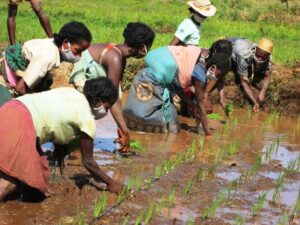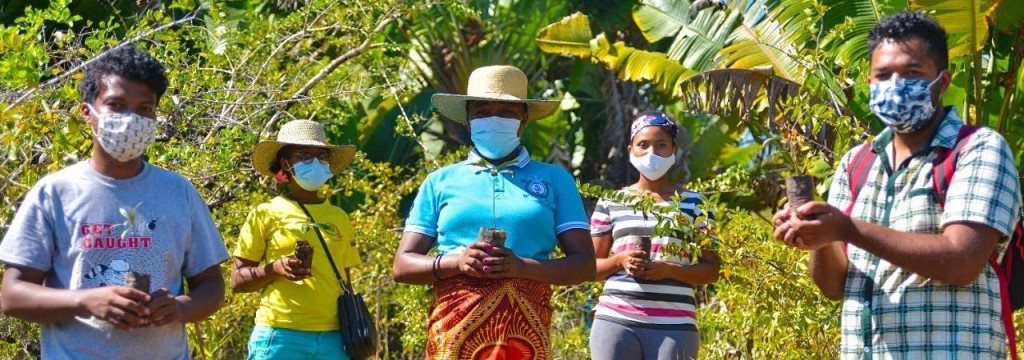Rainforest communities in Madagascar are implementing community designed, regenerative solutions to restore both degraded forests and community health in the Manombo forest, in partnership with the organization Health In Harmony.
Community-designed solutions include access to healthcare, alternative livelihoods and education; an integrated planetary health approach.
“The health of humans and the health of the environment are inextricably intertwined. If both are not healthy, neither can be,” said Kinari Webb, MD, Founder of Health In Harmony.
Background
 When it comes to knowing how to live in balance with our natural environment and ecosystems, rainforest communities are the experts.
When it comes to knowing how to live in balance with our natural environment and ecosystems, rainforest communities are the experts.
Through an approach called Radical Listening, Health In Harmony positions these communities as climate and conservation experts, and supports them in identifying and interrupting the root causes of rainforest degradation and deforestation.
“In our experience, rainforest communities don’t design siloed, sector-based solutions to reverse deforestation. Instead, they design exchange systems, consistently defined by the following interdependent elements: healthcare, conservation, livelihoods, and education,” added Webb.
The organization is working with rainforest communities in Indonesia, Brazil, and Madagascar to implement community-designed solutions and take them to scale.
At their first project in partnership with the Indonesian partner organization Alam Sehat Lestari (ASRI) in Indonesian Borneo, an investment of $5.2 million USD over 10 years led to the protection of ecosystems worth $65 million in carbon protected and primary forest loss stabilized, a 90% drop in illegal logging households and a 67% drop in infant mortality.
The Challenge
Despite legal protected status, the Manombo Rainforest in Madagascar is shrinking rapidly.
The drivers of biodiversity loss are clear: slash-and-burn agriculture and uncontrolled anthropogenic wildfires, rooted in the nutritional and economic poverty of local community members living around the Manombo Special Reserve.
Local communities suffer from extreme poverty, widespread malnutrition and inadequate healthcare. Climate change adds to those stresses, with extended droughts, frequent cyclones, and an unpredictable growing season. Climate-stressed communities are driven, in turn, to degrade forests through slash-and-burn agriculture and logging.
Climate and Health Solutions
In order to identify solutions to the degradation of the Manombo Rainforest, Health In Harmony asked the experts: the communities living in and around the rainforest. The communities identified the need for access to healthcare, alternative livelihoods and education.
“We have always wanted to protect the environment, for many years now. In the past, Madagascar was covered by forest, but most of those forests have disappeared. But the forest in Manombo has not disappeared completely. This is because we have always thought about the future generations. We have a strong social law for those who destroy or sell parts of the forest. The people that do so will have to pay or give a Zebu (a cow). That’s what our ancestors did before us. In the past, even if we were very hungry during the hunger season, we did not destroy the forest. We thank the central government because they told us to protect the forest. This forest is what makes Madagascar unique. It is our wealth,” says Mr. Bruno, Village Chief of the Tsaratanana Community.
Access to high-quality & affordable healthcare
The organization’s medical team provides healthcare by organizing mobile clinics in locations selected by the communities and accessible for all communities. Patients can pay for healthcare with non-cash means such as seedlings which are used in the reforestation and agroforestry programs.
Communities receive a discount for their healthcare based on how much their individual communities are extracting from, logging, and hunting in the rainforest, which is monitored by selected community members referred to as Forest Guardians. This incentive system motivates communities to protect the forest.
Healthcare services are coordinated with the national and regional Ministry of Health and directly support the health system’s capacity and resources.
“If I compare the different projects I’ve worked on, I see a positive difference in the way of working and the quality of work done by Health In Harmony up until now. It also offers a longer term solution. Health In Harmony provides healthcare that is close to the community, so it fits with my roles as a community health worker. Conservation is also really important for me. As a mother, and head of the family, I have to think of the future for my descendants and be a good example for them,” said Nelly Ranjemiarisoa, Community Health Worker and Community Liaison.
“I wanted to start the Women’s Association in my community because women are considered inferior and are not allowed to work in areas such as health or environment. I decided to create the Women’s Association, Varizatsy, here in Anivorano. It was very difficult to start the association. Everyone had their own way of thinking and it was not the same. Over time our association developed and when HIH came into the area I was encouraged to do more for the Women’s Association. Mainly because the health situation is very bad here. Many women die when they give birth, many kids don’t receive vaccinations, many people have malaria and many kids have worms in their bellies. So when the project arrived in the area I was motivated to work more on the Women’s Association. And when it developed the Association collaborated on the construction of the mobile clinic building. It was not only about the construction of the mobile clinic building, but we also did work on agriculture, association-based agriculture. We also put in work to build the road. We did all this work so we could have a safe building for healthcare for our community,” said Madame Fanja, Community member Anivorano and head of Women’s Association Anivorano.
Regenerative Livelihoods
Communities seek to shift away from slash and burn agriculture (known as tavy) to enhance land-use and minimize deforestation and forest fires. Community-designed training in regenerative agriculture covers fast-growing rice varieties which allow three harvests per year, composting to regenerate soil-fertility, and vegetable-gardening to support diverse diets.
The program has a focus on maintaining and enhancing crop variety to support diversified diets and integrating climate resilient crops and crop management, which will lead to higher yield agriculture and nutrient-dense diets.
Education
Communities asked for support in primary and secondary education for their children. The program intends to invest in strengthening the public school system by renovating community school buildings and hiring primary and secondary teachers.
“We try to sensitize parents to send their children to school. Before the school year starts we gather the parents and talk about the importance of education. We have a social law in place that is agreed upon by the parents and the parents association. When neighbors notice that children are not in school they will talk to the president of the parent association and they will discuss with the parents how they can support them to send their children to school. We value the importance of education in our community,” said a primary school teacher in Manombo.
Progress Achieved
Since the program in Manombo started in October 2020, the team did over 8000 consultations at the mobile clinic sites, providing primary care, family planning and vaccination services. Community health workers have received additional training, in close collaboration with 4 local health centers and the local hospital in the region.
Health In Harmony’s Agricultural Technicians have trained 2000 community members (60% women) in organic farming and rice cultivation techniques. They built 9 seedling nurseries with a capacity of 45,000 seedlings, and were able to reforest 10 ha inside the Manombo National Park. Additionally, they are working closely with communities to start implementing agroforestry programs.
62 Forest Guardians from the community were hired to monitor illegal forest degradation to apply the incentive system on healthcare services. The program supported infrastructure for 10 out of 13 schools in the region and will work closely with partners and the Ministry of Education to further support teachers and infrastructure needs for primary and secondary schools.
Lessons Learned
The organization’s team members have shared several key lessons they have learned from the project so far:
- The COVID-19 pandemic is the symptom of a sick planet. It exacerbated the need for a systems-oriented planetary health approach;
- Intersectional funding that supports multiple Sustainable Development Goals (SDGs) simultaneously is rare and scarce; and
- With just 9 years to significantly address the climate and nature crisis, there is a need to scale up quickly. Health In Harmony has replicated this approach in four rainforest sites in three countries: Indonesia, Brazil, and Madagascar.
Next Steps
The organization’s goal is to influence government and other initiatives to listen to and invest in community-designed solutions.
The various programs will continue to collect more data to understand the impact of community-driven solutions on halting forest loss.. Ultimately the organization plans to scale this model through partnerships, a virtual platform and advocacy.
All photos courtesy of WHO.
This article originally appeared on the website of the World Health Organization (WHO). Reprinted here (with minor edits) by permission.

